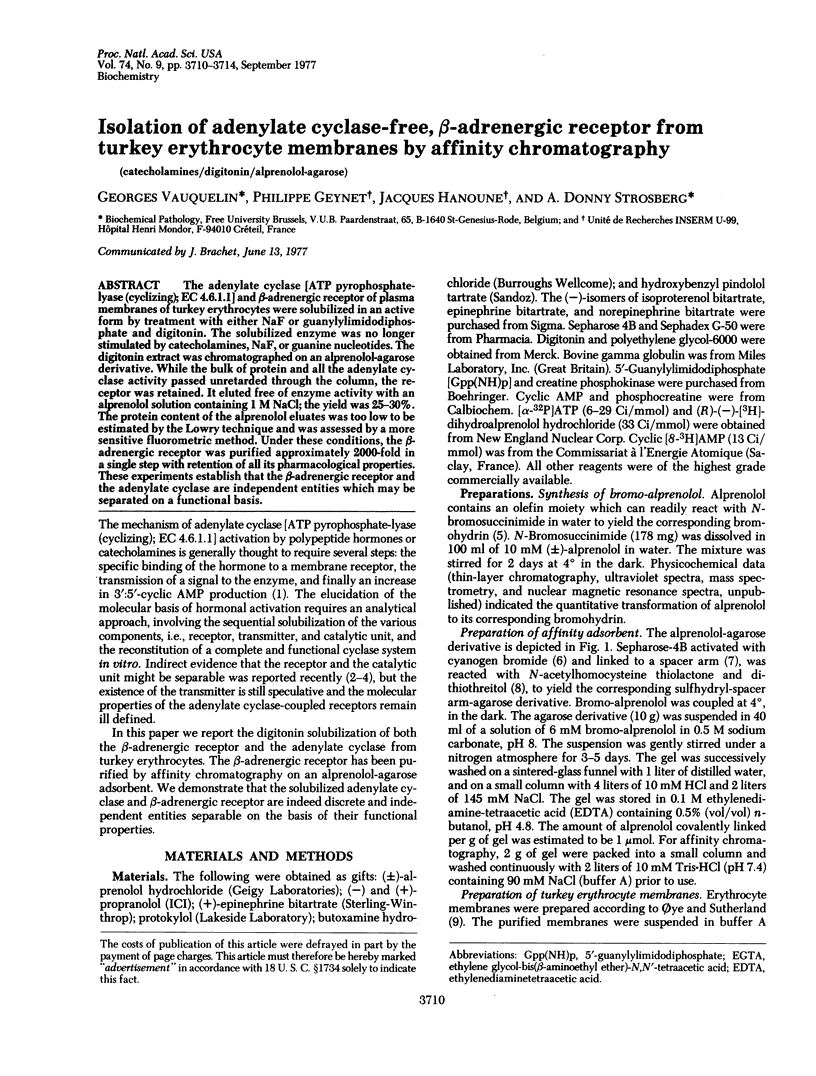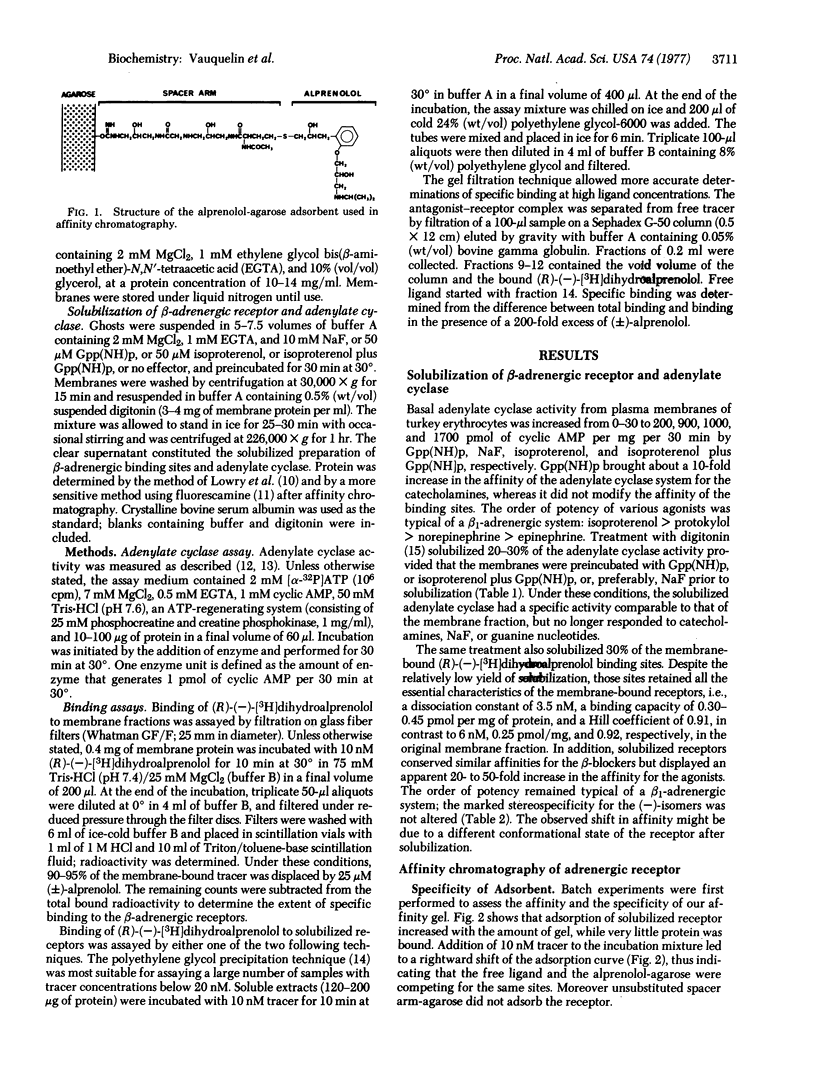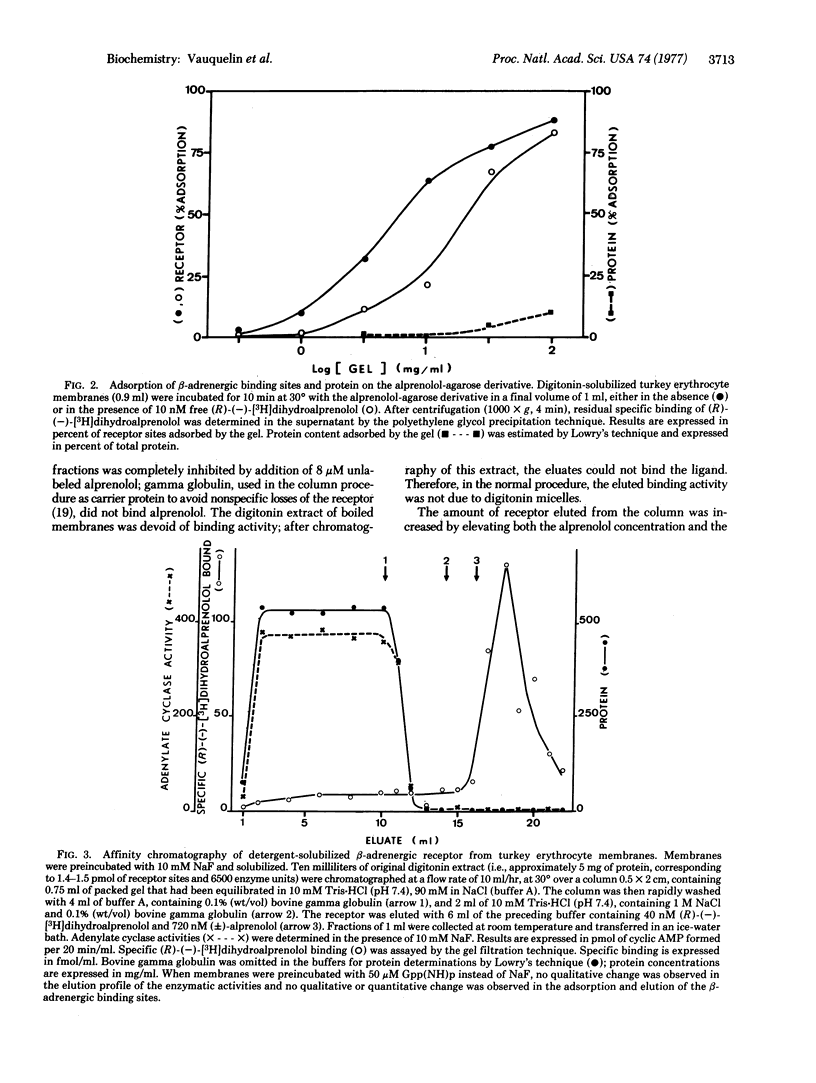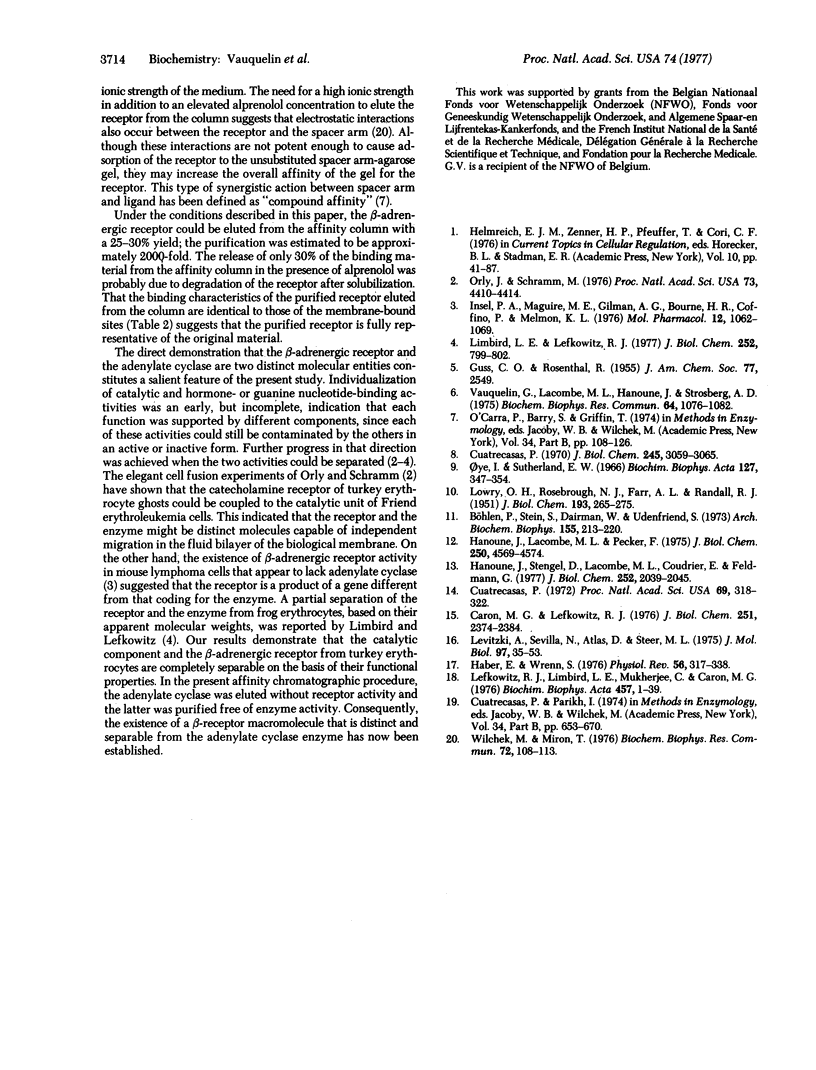Abstract
The adenylate cyclase [ATP pyrophosphatelyase (cyclizing); EC 4.6.1.1] and beta-adrenergic receptor of plasma membranes of turkey erythrocytes were solubilized in an active form by treatment with either NaF or guanylylimidodiphosphate and digitonin. The solubilized enzyme was no longer stimulated by catecholamines, NaF, or guanine nucleotides. The digitonin extract was chromatographed on an alprenolol-agarose derivative. While the bulk of protein and all the adenylate cyclase activity passed unretarded through the column, the receptor was retained. It eluted free of enzyme activity with an alprenolol solution containing 1 M NaCl; the yield was 25-30%. The protein content of the alprenolol eluates was too low to be estimated by the Lowry technique and was assessed by a more sensitive fluorometric method. Under these conditions, the beta-adrenergic receptor was purified approximately 2000-fold in a single step with retention of all its pharmacological properties. These experiments establish that the beta-adrenergic receptor and the adenylate cyclase are independent entities which may be separated on a functional basis.
Full text
PDF




Selected References
These references are in PubMed. This may not be the complete list of references from this article.
- Böhlen P., Stein S., Dairman W., Udenfriend S. Fluorometric assay of proteins in the nanogram range. Arch Biochem Biophys. 1973 Mar;155(1):213–220. doi: 10.1016/s0003-9861(73)80023-2. [DOI] [PubMed] [Google Scholar]
- Caron M. G., Lefkowitz R. J. Solubilization and characterization of the beta-adrenergic receptor binding sites of frog erythrocytes. J Biol Chem. 1976 Apr 25;251(8):2374–2384. [PubMed] [Google Scholar]
- Cuatrecasas P. Isolation of the insulin receptor of liver and fat-cell membranes (detergent-solubilized-( 125 I)insulin-polyethylene glycol precipitation-sephadex). Proc Natl Acad Sci U S A. 1972 Feb;69(2):318–322. doi: 10.1073/pnas.69.2.318. [DOI] [PMC free article] [PubMed] [Google Scholar]
- Cuatrecasas P. Protein purification by affinity chromatography. Derivatizations of agarose and polyacrylamide beads. J Biol Chem. 1970 Jun;245(12):3059–3065. [PubMed] [Google Scholar]
- Haber E., Wrenn S. Problems in identification of the beta-adrenergic receptor. Physiol Rev. 1976 Apr;56(2):317–338. doi: 10.1152/physrev.1976.56.2.317. [DOI] [PubMed] [Google Scholar]
- Hanoune J., Lacombe M. L., Pecker F. The epinephrine-sensitive adenylate cyclase of rat liver plasma membranes. Role of guanyl nucleotides. J Biol Chem. 1975 Jun 25;250(12):4569–4574. [PubMed] [Google Scholar]
- Hanoune J., Stengel D., Lacombe M. L., Feldmann G., Coudrier E. Proteolytic activation of rat liver adenylate cyclase by a contaminant of crude collagenase from Clostridium histolyticum. J Biol Chem. 1977 Mar 25;252(6):2039–2045. [PubMed] [Google Scholar]
- Insel P. A., Maguire M. E., Gilman A. G., Bourne H. R., Coffino P., Melmon K. L. Beta adrenergic receptors and adenylate cyclase: products of separate genes? Mol Pharmacol. 1976 Nov;12(6):1062–1069. [PubMed] [Google Scholar]
- LOWRY O. H., ROSEBROUGH N. J., FARR A. L., RANDALL R. J. Protein measurement with the Folin phenol reagent. J Biol Chem. 1951 Nov;193(1):265–275. [PubMed] [Google Scholar]
- Lefkowitz R. J., Limbird L. E., Mukherjee C., Caron M. G. The beta-adrenergic receptor and adenylate cyclase. Biochim Biophys Acta. 1976 Apr 13;457(1):1–39. doi: 10.1016/0304-4157(76)90012-5. [DOI] [PubMed] [Google Scholar]
- Levitzki A., Sevilia N., Atlas D., Steer M. L. Ligand specificity and characteristics of the beta-adrenergic receptor in turkey erythrocyte plasma membranes. J Mol Biol. 1975 Sep 5;97(1):35–46. [PubMed] [Google Scholar]
- Limbird L. E., Lefkowitz R. J. Resolution of beta-adrenergic receptor binding and adenylate cyclase activity by gel exclusion chromatography. J Biol Chem. 1977 Jan 25;252(2):799–802. [PubMed] [Google Scholar]
- Orly J., Schramm M. Coupling of catecholamine receptor from one cell with adenylate cyclase from another cell by cell fusion. Proc Natl Acad Sci U S A. 1976 Dec;73(12):4410–4414. doi: 10.1073/pnas.73.12.4410. [DOI] [PMC free article] [PubMed] [Google Scholar]
- Oye I., Sutherland E. W. The effect of epinephrine and other agents on adenyl cyclase in the cell membrane of avian erythrocytes. Biochim Biophys Acta. 1966 Oct 31;127(2):347–354. doi: 10.1016/0304-4165(66)90389-8. [DOI] [PubMed] [Google Scholar]
- Vanquelin G., Lacombe M. L., Hanoune J., Strosberg A. D. Stability of isoproterenol bound to cyanogen bromide-activated agarose. Biochem Biophys Res Commun. 1975 Jan 2;64(3):1076–1082. doi: 10.1016/0006-291x(75)90157-6. [DOI] [PubMed] [Google Scholar]
- Wilchek M., Miron T. On the mode of adsorption of proteins to "hydrophobic columns". Biochem Biophys Res Commun. 1976 Sep 7;72(1):108–113. doi: 10.1016/0006-291x(76)90967-0. [DOI] [PubMed] [Google Scholar]


